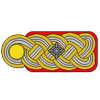
Since this project deals with a rail car mounted Pzkpfw IV-H turret, it makes sense that the build would begin with the car chassis itself as the first sub-assembly. Step 1 has three sub-steps to complete the construction of the undercarriage.
The first sub-assembly is the spring and hub mounts for the wheel trucks. The springs are nicely represented but have prominent mold seams on the spring tops that have to be dealt with. The springs mount directly to the hub base via a post mount and the hub faces are made of three separate parts with some very nicely molded cast in lettering detail.
The axles have hex-keyed ends that match up to the hub ends and trap the wheels between the hubs and the axles and small insert, A13, that is a spacer to insure the wheels are placed at the correct distance from the hubs. The fit on the hex-key end is tight enough that no glue was necessary and I likewise didn't glue the A13 inserts or the wheels, which allows the wheels to rotate freely, something that will be handy later on for painting.

The second sub-assembly deals with the wheel wells. There are four of these, labeled D8-D11 and I'd recommend you mark these somehow with a Sharpie to keep them apart. I didn't do this and it caused a little head-scratching as I built them up because they look very similar to each other but aren't quite exactly the same. More on that in just a bit. Each well receives 4 parts, 2 mounts for the springs and 2 pistons for the brake arms. The brake arms are mounted directly to the back panel of the well and then matched up to the pistons. The directions here have an error, they have an arrow showing the brake arm attaching to the spring mount, something that's not physically possible if you try it. As you can see in the photo below, there are large ejector marks present on the interior of the wells, but these won't be visible unless someone flips the whole car upside down, so I didn't spend time on filling and sanding them.

The third sub-assembly is to get the axles/wheels into their respective wells. This is a little tricky as the only installation points are the springs themselves, so a nice level surface is necessary to get them to glue to both wells and be straight for installation.

Step 2 directs for these to be installed into the hull of the car. There are molded in points for them to mate up to and this is where it's important to remember which of the earlier D8-D11 is which. When the axles are installed into the wells, they pair up, but it's possible to get them switched around if not paying close attention. When this happens, you will know right away as the slope angles where they meet front vs. rear are slightly different. When mismatched, they look like this:

And when properly installed fore and aft, it looks like this:

Once placed in the proper spots, the well tops sit below the rim which is how they should to allow proper fit for the upper deck plate. I dry-fit this just to be sure and everything is in good order for the next steps.


























































